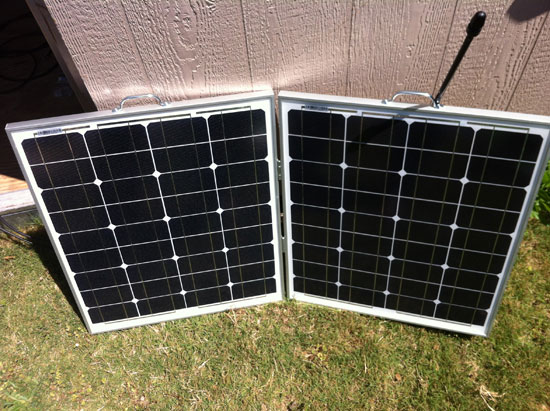There’s nothing worse that running out of power. We use power so much every day that it has become one of those things we take for granted. Unfortunately a sudden loss of power can send you back to the dark ages, ruining your refrigerator contents, preventing you from pumping water, and keeping your electric stove and electronic gadgets from working. A typical back up generator certainly helps, but only as long as you have fuel for it. A generator with a full tank of gas can only last about 8 hours under a light load. At that point, you’ll have to get more gasoline for it. In a camping situation, that can be inconvenient.
What about a homemade solar generator? Using the power of the sun, and some spare batteries, you can have a generator with a constantly renewable energy source. Say good bye to those trips for fuel for good.
[nggallery id=2 w=150 h=150]The Parts
This solar generator is made of 2 marine deep cycle batteries, 2 40watt solar panels, 1 charge controller and 1 power inverter. The two 85 amp/hr batteries give you 85 hours of 2 amp usage (a simple fan uses about 4 amps/hr, so this fan would run about 40 hrs straight in this configuration). The modified sine wave power inverter is a 2000 watt device that will help you power many things: Power tools, lights, fans, pumps, you name it. It will even recharge many electronic devices. You won’t want to power just anything though. The smallest air conditioners use about 600 watts. (2-3 times that for anything that generates heat) So while this power inverter would successfully run a small portable window unit A/C, it wouldn’t run it very long. The charge controller regulates the electricity from the solar panels to the batteries. Batteries don’t like being overcharged, or undercharged. These devices manage all of that. The solar panels on this unit recharge the batteries at about 5 amps per hour in direct sunlight. You have to figure on about 5 hours of quality sunlight per day for them. Anything else is indirect and only provides some recharging. More solar panels will recharge the unit faster. Larger solar panels will too, but they become harder to manage. At the end of the day, many people will appreciate having a quiet back up power source that they don’t have to constantly be searching for fuel for, not to mention how clean the energy is and better for the environment.
Some Caveats
- Modified sine wave inverters – They’re cheaper, but you shouldn’t use them with sensitive electronics. It will fry them. Insist on a pure sine wave inverter instead. It’s a little more expensive, but it won’t fry your iphone.
- It’s heavy. Have you picked up a car battery lately? Try two. This system works a lot easier with a heavy duty dolly.
- Opt for using thick cables between your batteries and your inverter. 6 ga or larger. Throw in a fuse to make it fire safe.
- The dolly. Don’t use the one pictured. Get the heavier duty ones with bigger tires. That will help you roll it out across gravel and loose dirt.
- Batteries. Keep your batteries at or above 60-70% charged at all times to extend their life. “deep cycle” marine batteries like the ones shown cost about $70-$100 each at Sams/Autozone. The more batteries you have, the longer it takes them to discharge down to the 60-70% level.
Kill-A-Watt Tool Tip
To better understand how much power your devices use, get a Kill-A-Watt tool from Lowes or online. It will help you see how many watts an electronic device uses. Before launching into building your own backup power generator, check out the other examples online.

